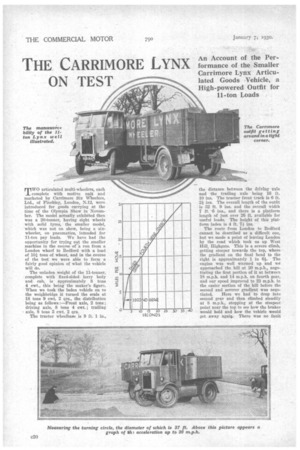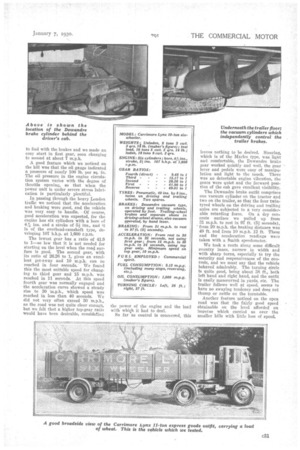THE CARRIMORE LYNX ON TEST
Page 52

Page 53

If you've noticed an error in this article please click here to report it so we can fix it.
An Account of the Performance of the Smaller Carrimore Lynx Articulated Goods Vehicle, a High-powered Outfit for
11-ton Loads
TWO articulated multi-wheelers, each complete with motive unit and marketed by Carrimore Six Wheelers, Ltd., of Finchley, London, N.12, were introduced for goods carrying at the time of the Olympia Show in November. The model actually exhibited then was a 20-tonner, having eight wheels with solid tyres, • the smaller model, which was not on show, being a sixwheeler, on pneumatics, intended for 11-ton pay loads. We have had the opportunity for trying out the smaller machine in the course of run from a London wharf to Bedford with a load of 10i tons of wheat, and in the course of the test we were able to form a fairly good opinion of what the vehicle will do.
The unladen weight of the 11-tonner, complete with fixed-sided lorry body and cab, is approximately 8 tons 4 cwt., this being the maker's figure. When we took the laden vehicle on to the weighbridge it turned the scale at 18 tons 9 cwt, 2 qrs., the distribution being as follows :—Front axle, 2 tons; driving axle, 8 tons 4 cwt.; trailing axle, 8 tons 5 cwt. 2 qrs.
The tractor wheelbase is 9 ft. 1 in., the distance between the drivingaxle and the trailing axle being 16 ft. 10 ins. The tractor front track is 6 ft. 21 ins. The overall length of the outfit is 32 ft. 9 ins, and the overall width 7 ft. 6 ins., and there is a platform length of just over 26 ft. available for useful loads. The height of this platform laden is 4 ft. 71 ins.
The route from London to Bedford cannot be described as a difficult one, but we made a point of leaving London by the road which took us up West Hill, Highgate. This is a severe climb, getting steeper towards the top, where the gradient on the final bend to the right is approximately 1 in 61. The engine was well warmed up and w6 approached the hill at 20 m.p.h., negotiating the first portion of it at between 18 m.p.h. and 14 m.p.h. on fourth gear, and our speed improved to 23 m.p.h. in the easier section of the hill before the second and severer gradient was nego tiated. Here we had to drop into second gear and then climbed steadily at 8 m.p.h., stopping at the steepest point near the top to see how the brakes would hold and how the vehicle would get away agaiu. There was no fault to find with the brakes and we made an easy start in first gear, soon changing to second at about 7 m.p.h.
A good feature which we noticed on the hill was that the oil gauge indicated a pressure of nearly 100 lb. per sq. in. The oil pressure in the engine circulation system varies with the degree of throttle opening, so that when the power unit is under severe stress lubrication is particularly plentiful.
In passing through the heavy London traffic we noticed that the acceleration and braking were good, and the vehicle was very easy to handle. Of course, good acceleration was expected, for the engine has six cylinders with a bore of 4,96 ins, and a stroke of 5i ins., and it is of the overhead-camshaft type, developing 107 b.h.p. at 1,600 r.p.m.
The lowest gear has a ratio of 41.9 to 1—so low that it is not needed for starting on the level when the road surface is good. The second gear, with its ratio of 26.26 to 1, gives an excellent get-away and 10 m.p.h. can no reached in four seconds. We found this the most suitable speed for changing to third gear and 15 m.p.h. was reached in 11 seconds. At this speed fourth gear was normally engaged and the acceleration curve showed a steady rise to 30 'm.p.h., which speed was reached in less than 40 seconds. We did not very often exceed 80 m.p.h., as the road was not quite clear enough, but we felt that a higher top-gear ratio would have been desirable, considena4 the power of the engine and the load with whigh it had to deal.
So far as control is concerired, this • leaves nothing to be desired. Steering, which is of the Merles type, was light and coinfortable, the Dewandre brake gear worked quickly and well, the gear lever and pedals were easy of manipulation and light to the touch. There was no detectable engine vibration, the gears were quiet and the forward position of the cab gave excellent visibility.
The Dewandre brake outfit comprises one vacuum cylinder on the tractor and two on the trailer, so that the four twintyred wheels on the driving and trailing axles are subjected to a very considerable retarding force. On a dry concrete surface we pulled up from 31 m.p.h. to rest in 97 ft. (51 seconds),
• from 20 m.p.h. the braking distance was 49 ft. and from 10 m.p.h. 12 ft. These and the acceleration readings were taken with a Smith 8pedometer.
We took a route along some difficult country lanes, narrow in width and with sharp turns, especially to try the security and responsiveness of the controls, and we must say that the vehicle behaved admirably. The turning circle Is quite good, being about 38 ft, both left hand and right band, and the outfit is easily manceuvred in yards, etc. The trailer follows well at speed, seems to have no swaying tendency and does. not thump or rattle on the turntable.
Another feature noticed on the open road was that the fairly good speed obtainable on the level afforded an impetus which carried us over the smaller hills with little lass of speed.












































































































